Seven compounds were isolated and characterized from the culture broth of the marine bacteria Nocardiopsis sp. (strain G057), which was isolated from sediment collecting at Cô Tô – Quảng Ninh. Their structures were determined by spectroscopic analysis inc
Seven compounds were isolated and characterized from the culture broth of the marine bacteria
Nocardiopsis sp. (strain G057), which was isolated from sediment collecting at Cô Tô – Quảng Ninh. Their
structures were determined by spectroscopic analysis including MS and 2D NMR, as well as by comparison
with reported data in the literature. All compounds were evaluated for their antimicrobial activity against a
panel of clinically significant microorganisms. Compounds 1, 2 and 7 selectively inhibited Escherichia coli
with a MIC value of 32, 64, 8 μg/mL, respectively. Compound 3 exhibited antimicrobial activity against
several strains of both gram-positive and gram-negative bacteria
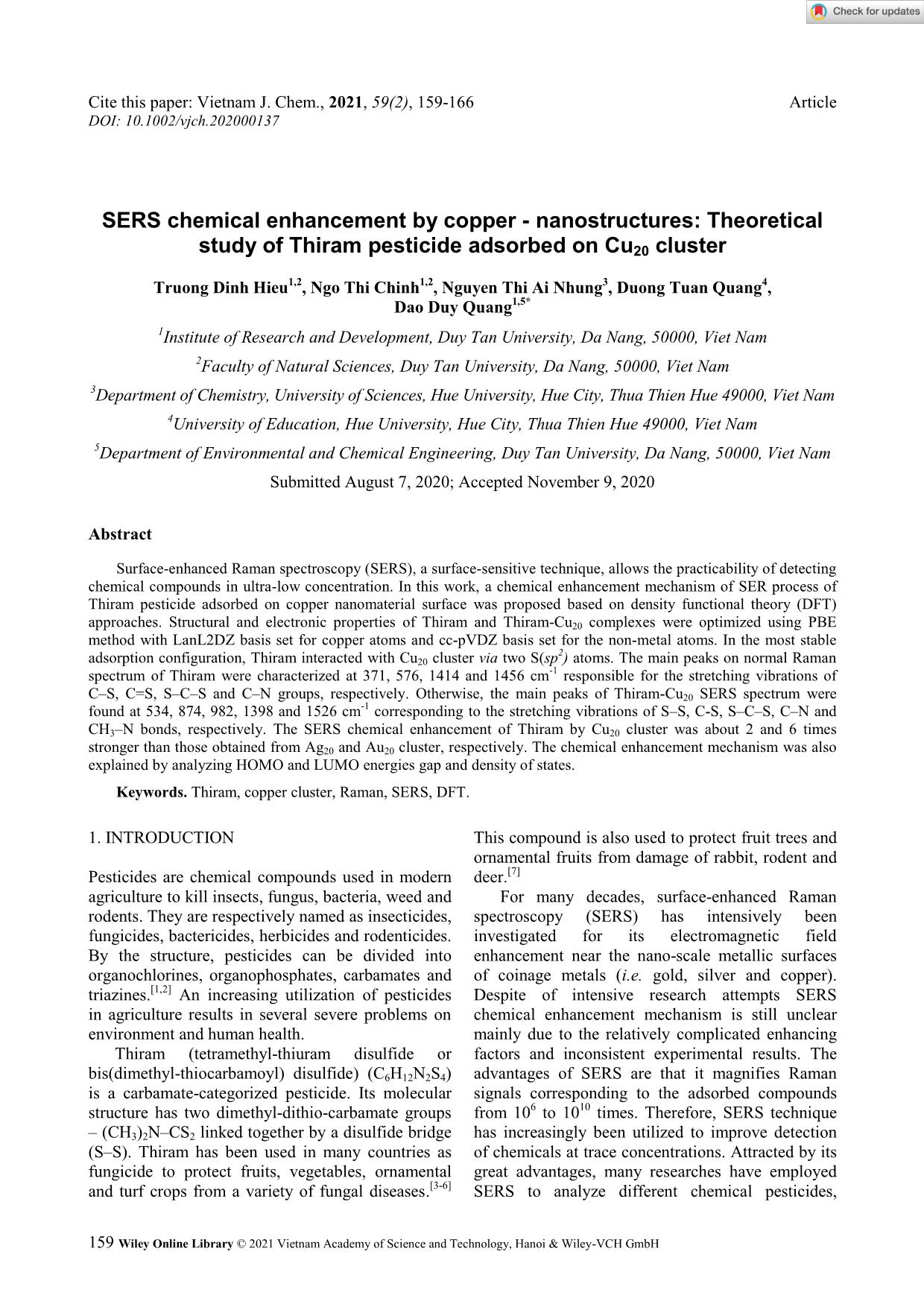
Trang 1
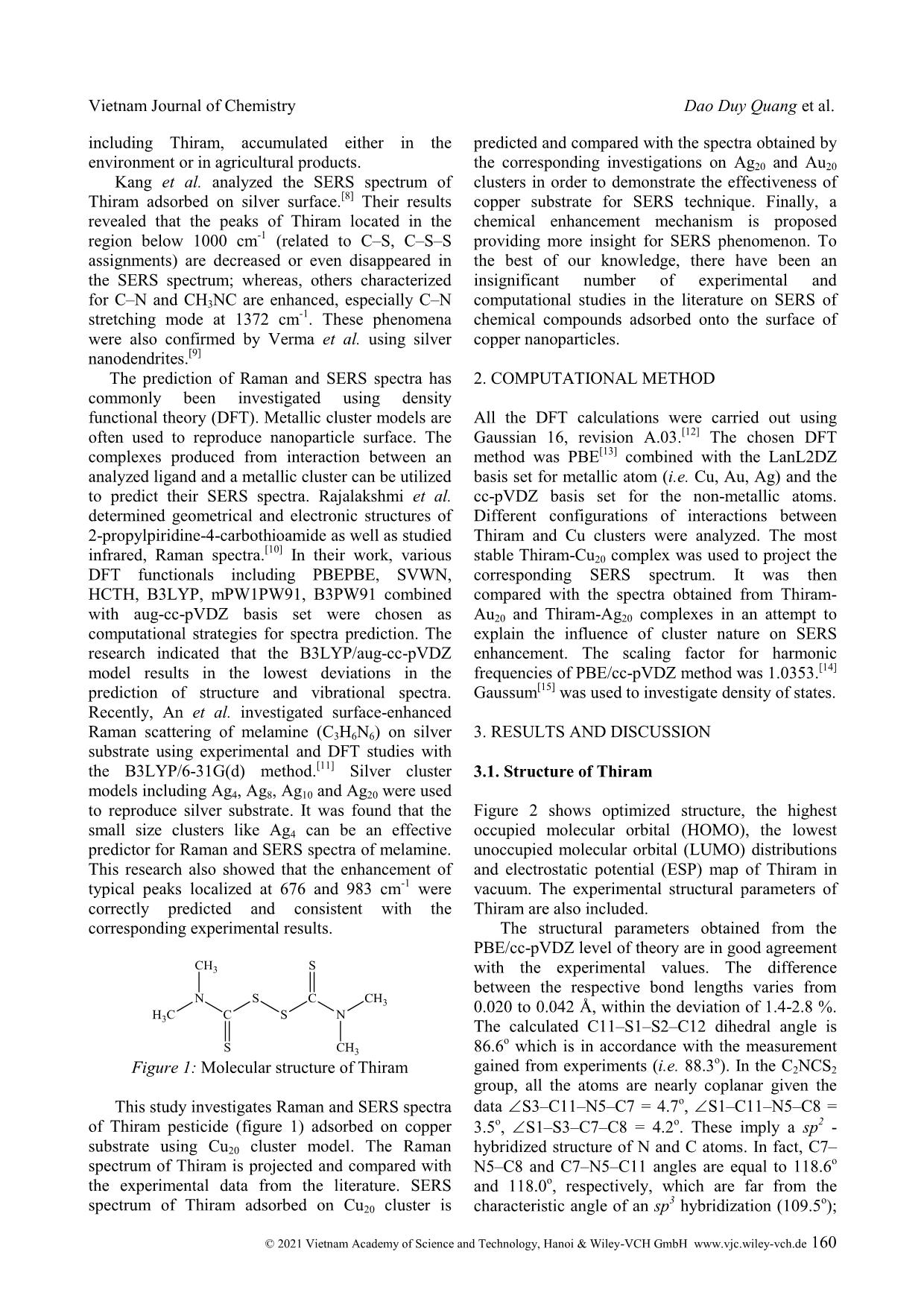
Trang 2
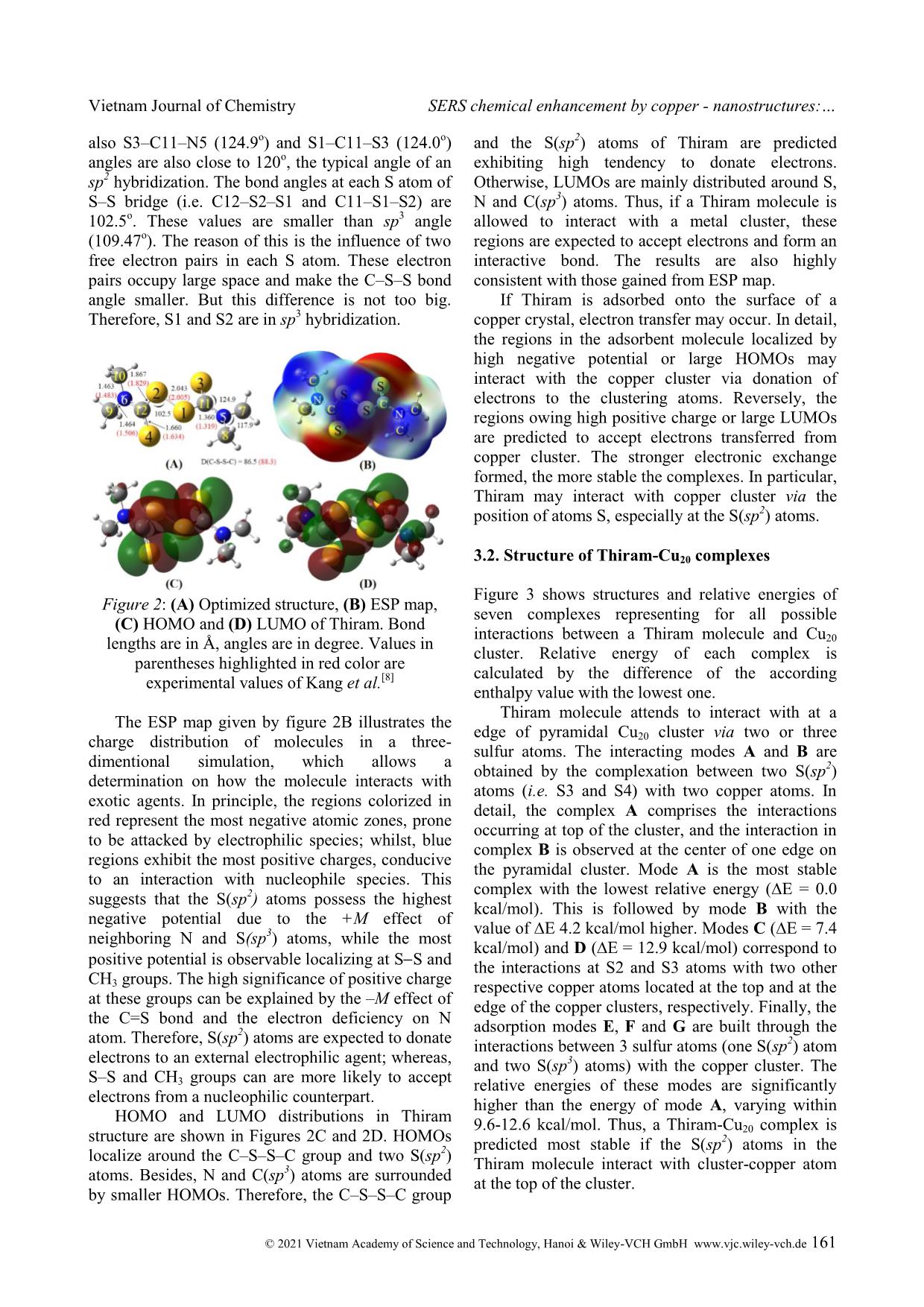
Trang 3
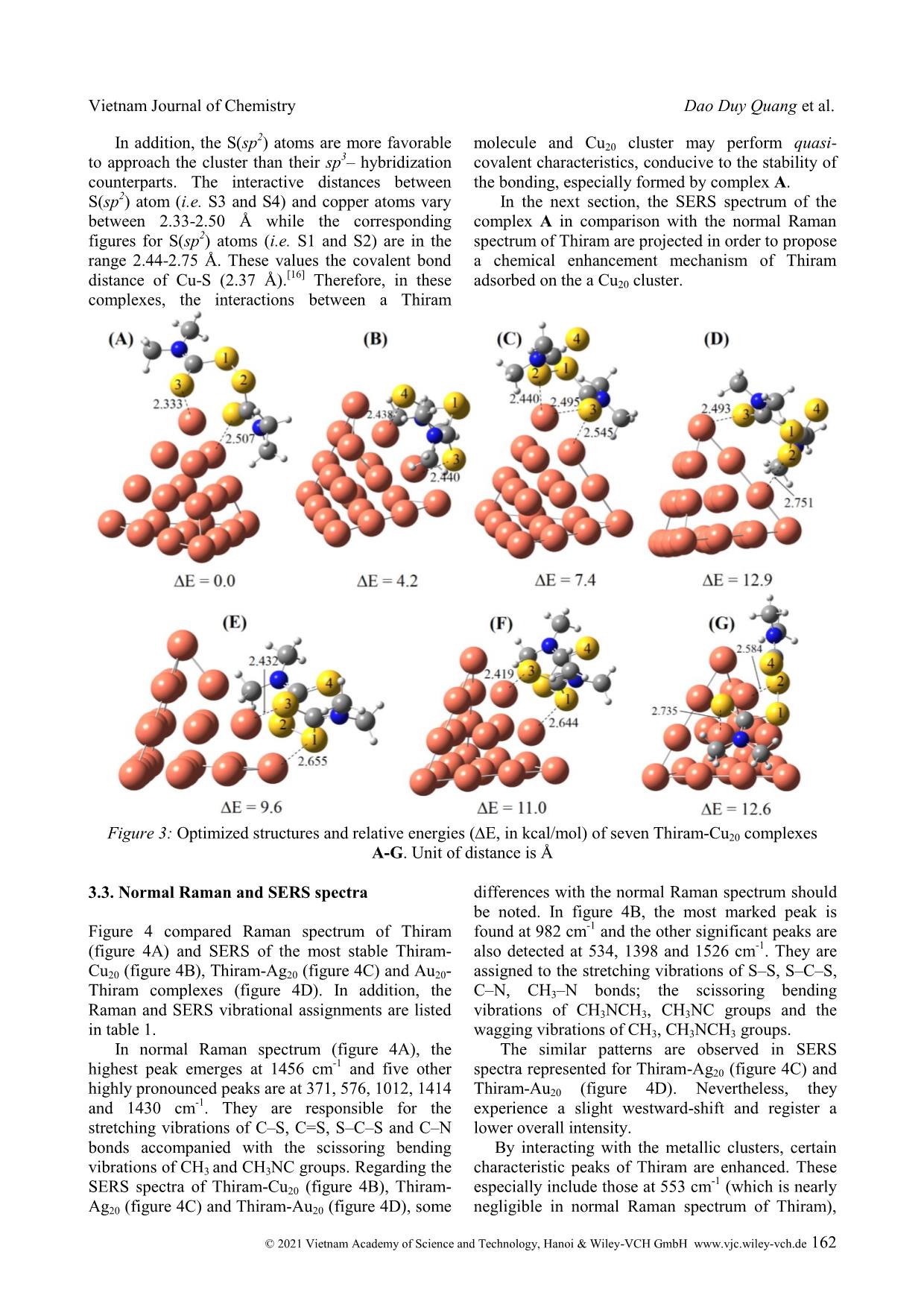
Trang 4
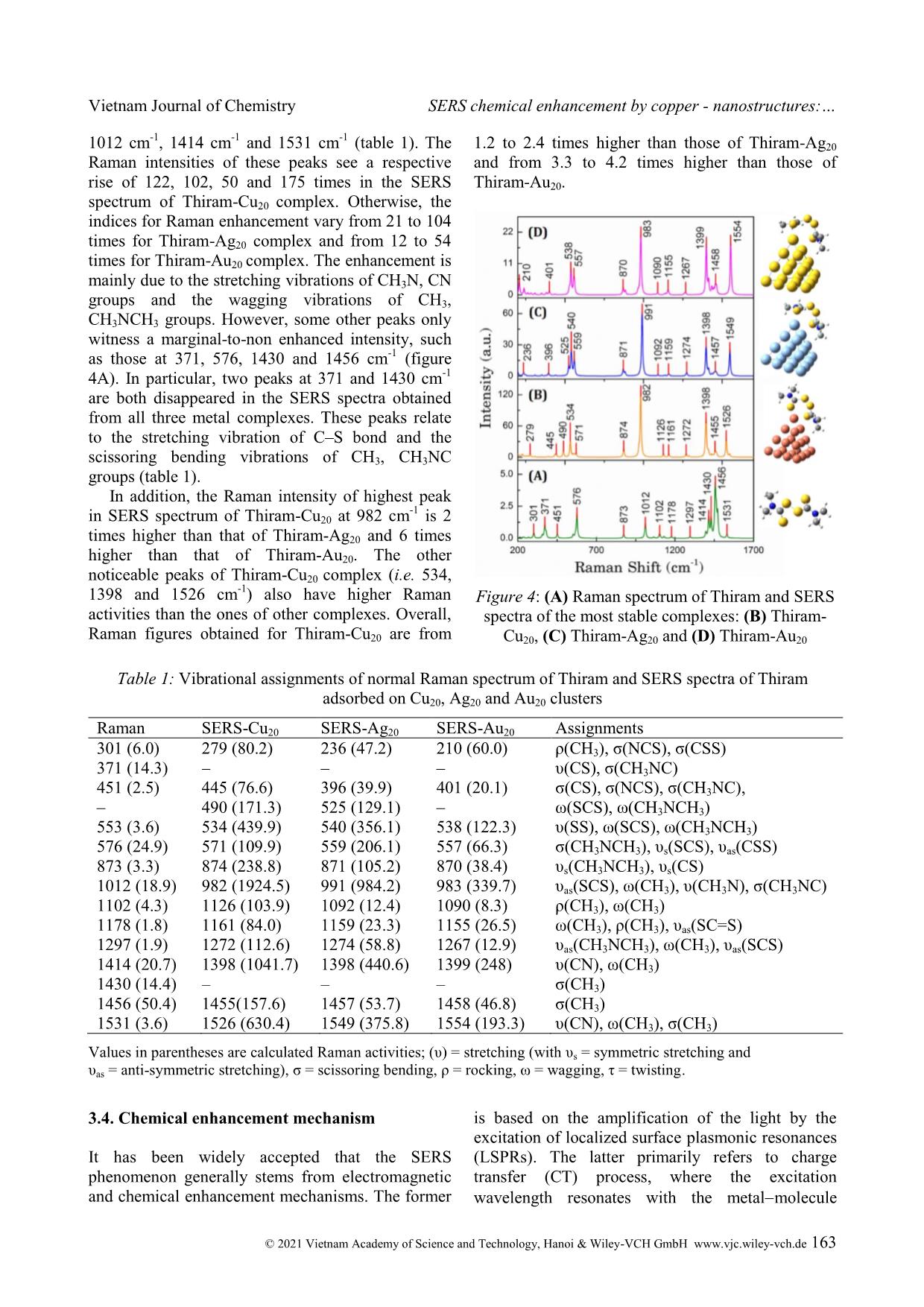
Trang 5
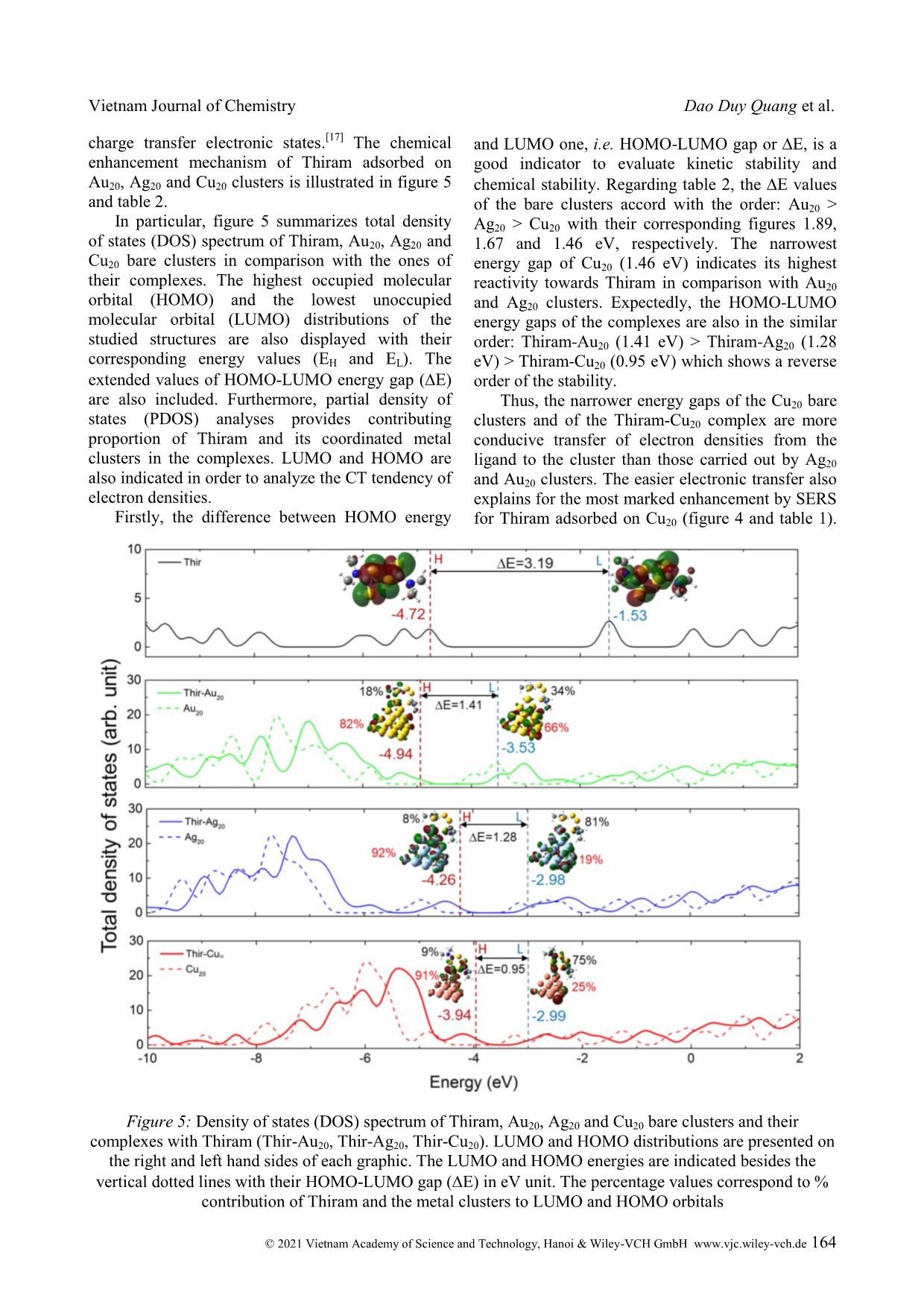
Trang 6
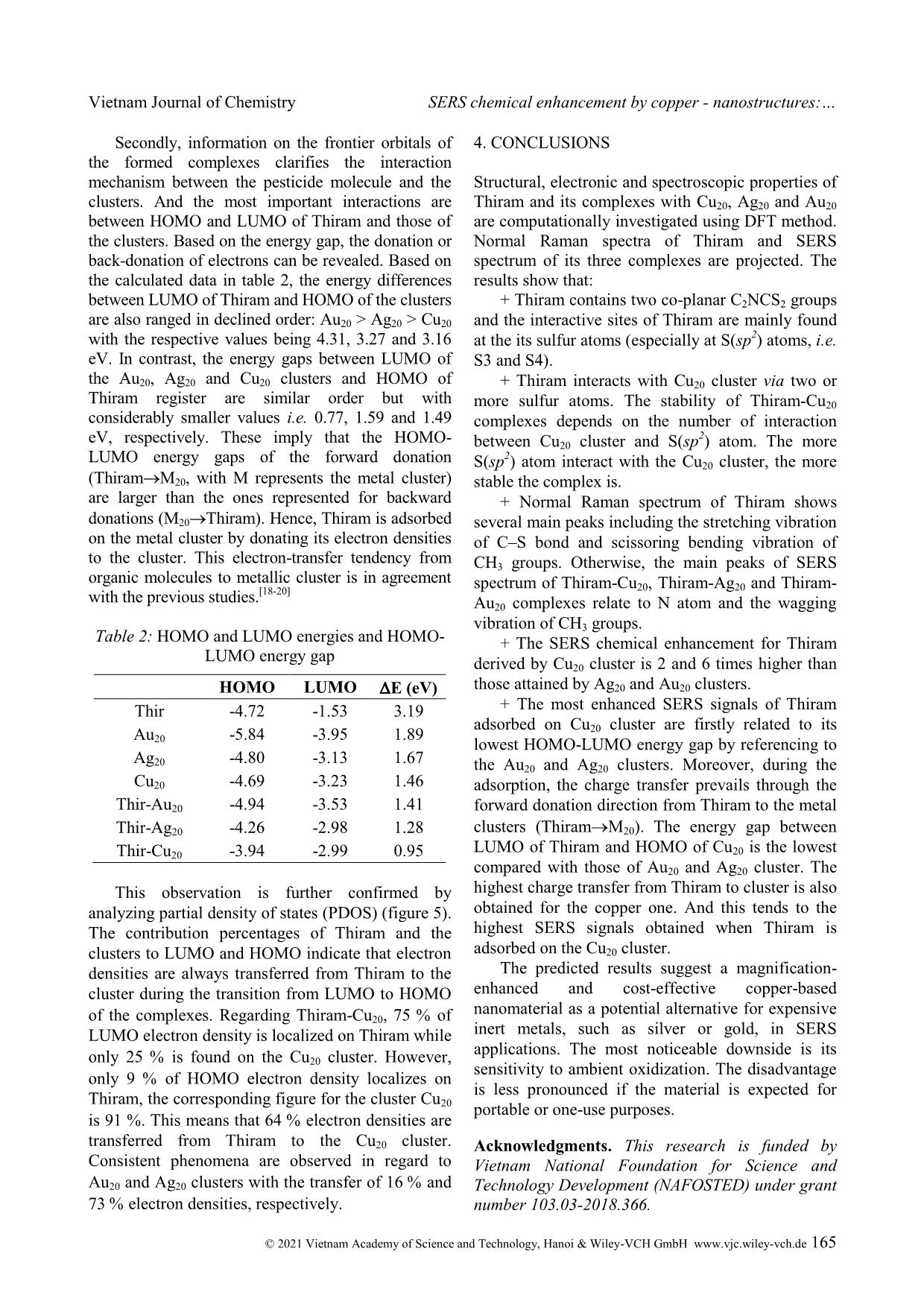
Trang 7
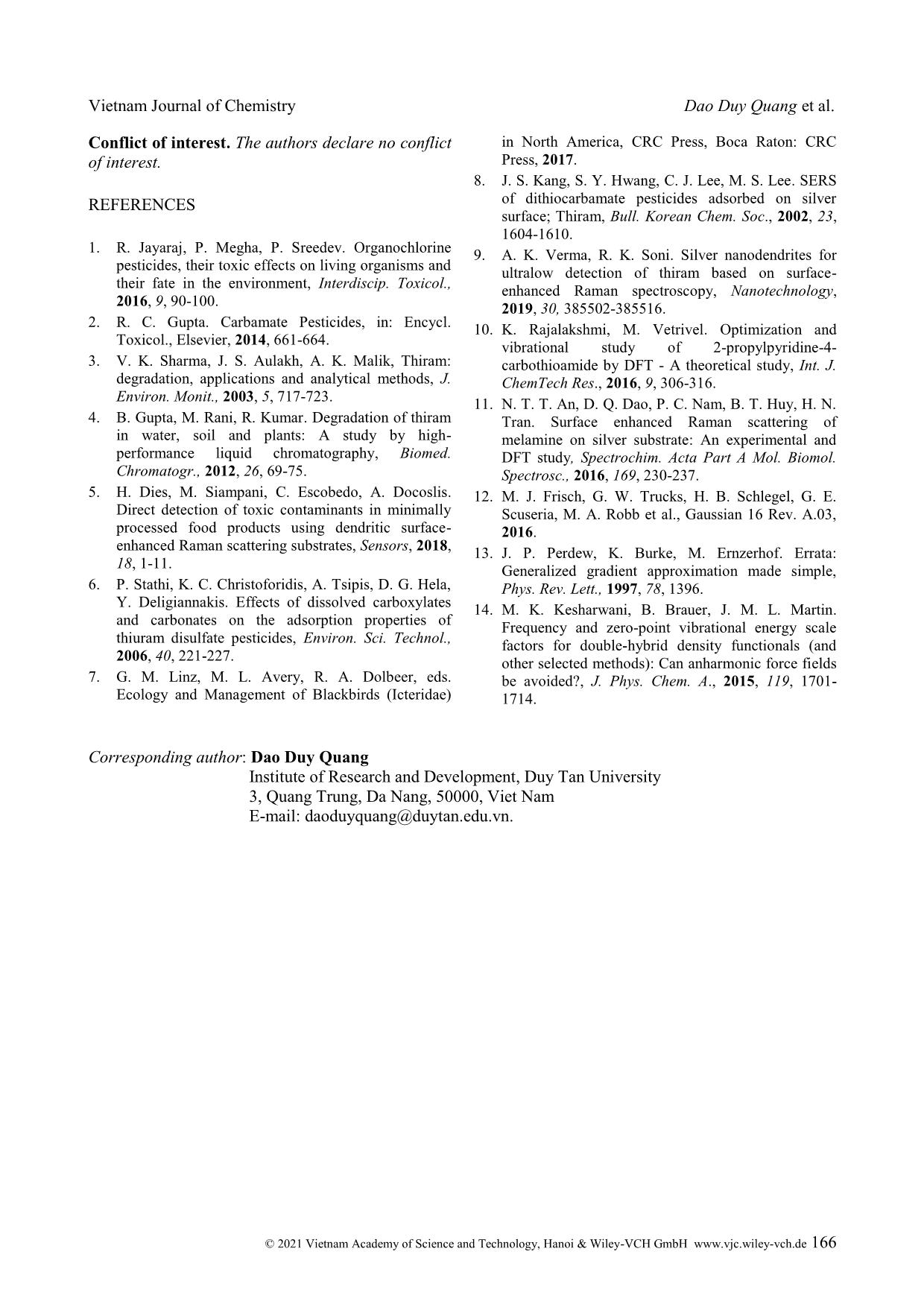
Trang 8
Tóm tắt nội dung tài liệu: Seven compounds were isolated and characterized from the culture broth of the marine bacteria Nocardiopsis sp. (strain G057), which was isolated from sediment collecting at Cô Tô – Quảng Ninh. Their structures were determined by spectroscopic analysis inc
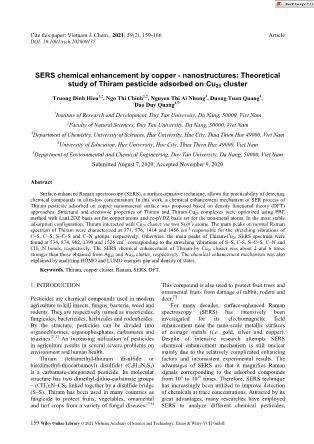
Cite this paper: Vietnam J. Chem., 2021, 59(2), 159-166 Article DOI: 10.1002/vjch.202000137 159 Wiley Online Library © 2021 Vietnam Academy of Science and Technology, Hanoi & Wiley-VCH GmbH SERS chemical enhancement by copper - nanostructures: Theoretical study of Thiram pesticide adsorbed on Cu20 cluster Truong Dinh Hieu 1,2 , Ngo Thi Chinh 1,2 , Nguyen Thi Ai Nhung 3 , Duong Tuan Quang 4 , Dao Duy Quang 1,5* 1 Institute of Research and Development, Duy Tan University, Da Nang, 50000, Viet Nam 2 Faculty of Natural Sciences, Duy Tan University, Da Nang, 50000, Viet Nam 3 Department of Chemistry, University of Sciences, Hue University, Hue City, Thua Thien Hue 49000, Viet Nam 4 University of Education, Hue University, Hue City, Thua Thien Hue 49000, Viet Nam 5 Department of Environmental and Chemical Engineering, Duy Tan University, Da Nang, 50000, Viet Nam Submitted August 7, 2020; Accepted November 9, 2020 Abstract Surface-enhanced Raman spectroscopy (SERS), a surface-sensitive technique, allows the practicability of detecting chemical compounds in ultra-low concentration. In this work, a chemical enhancement mechanism of SER process of Thiram pesticide adsorbed on copper nanomaterial surface was proposed based on density functional theory (DFT) approaches. Structural and electronic properties of Thiram and Thiram-Cu20 complexes were optimized using PBE method with LanL2DZ basis set for copper atoms and cc-pVDZ basis set for the non-metal atoms. In the most stable adsorption configuration, Thiram interacted with Cu20 cluster via two S(sp 2 ) atoms. The main peaks on normal Raman spectrum of Thiram were characterized at 371, 576, 1414 and 1456 cm -1 responsible for the stretching vibrations of C–S, C=S, S–C–S and C–N groups, respectively. Otherwise, the main peaks of Thiram-Cu20 SERS spectrum were found at 534, 874, 982, 1398 and 1526 cm -1 corresponding to the stretching vibrations of S–S, C-S, S–C–S, C–N and CH3–N bonds, respectively. The SERS chemical enhancement of Thiram by Cu20 cluster was about 2 and 6 times stronger than those obtained from Ag20 and Au20 cluster, respectively. The chemical enhancement mechanism was also explained by analyzing HOMO and LUMO energies gap and density of states. Keywords. Thiram, copper cluster, Raman, SERS, DFT. 1. INTRODUCTION Pesticides are chemical compounds used in modern agriculture to kill insects, fungus, bacteria, weed and rodents. They are respectively named as insecticides, fungicides, bactericides, herbicides and rodenticides. By the structure, pesticides can be divided into organochlorines, organophosphates, carbamates and triazines. [1,2] An increasing utilization of pesticides in agriculture results in several severe problems on environment and human health. Thiram (tetramethyl-thiuram disulfide or bis(dimethyl-thiocarbamoyl) disulfide) (C6H12N2S4) is a carbamate-categorized pesticide. Its molecular structure has two dimethyl-dithio-carbamate groups – (CH3)2N–CS2 linked together by a disulfide bridge (S–S). Thiram has been used in many countries as fungicide to protect fruits, vegetables, ornamental and turf crops from a variety of fungal diseases. [3-6] This compound is also used to protect fruit trees and ornamental fruits from damage of rabbit, rodent and deer. [7] For many decades, surface-enhanced Raman spectroscopy (SERS) has intensively been investigated for its electromagnetic field enhancement near the nano-scale metallic surfaces of coinage metals (i.e. gold, silver and copper). Despite of intensive research attempts SERS chemical enhancement mechanism is still unclear mainly due to the relatively complicated enhancing factors and inconsistent experimental results. The advantages of SERS are that it magnifies Raman signals corresponding to the adsorbed compounds from 10 6 to 10 10 times. Therefore, SERS technique has increasingly been utilized to improve detection of chemicals at trace concentrations. Attracted by its great advantages, many researches have employed SERS to analyze different chemical pesticides, Vietnam Journal of Chemistry Dao Duy Quang et al. © 2021 Vietnam Academy of Science and Technology, Hanoi & Wiley-VCH GmbH www.vjc.wiley-vch.de 160 including Thiram, accumulated either in the environment or in agricultural products. Kang et al. analyzed the SERS spectrum of Thiram adsorbed on silver surface. [8] Their results revealed that the peaks of Thiram located in the region below 1000 cm -1 (related to C–S, C–S–S assignments) are decreased or even disappeared in the SERS spectrum; whereas, others characterized for C–N and CH3NC are enhanced, especially C–N stretching mode at 1372 cm -1 . These phenomena were also confirmed by Verma et al. using silver nanodendrites. [9] The prediction of Raman and SERS spectra has commonly been investigated using density functional theory (DFT). Metallic cluster models are often used to reproduce nanoparticle surface. The complexes produced from interaction between an analyzed ligand and a metallic cluster can be utilized to predict their SERS spectra. Rajalakshmi et al. determined geometrical and electronic structures of 2-propylpiridine-4-carbothioamide as well as studied infrared, Raman spectra. [10] In their work, various DFT functionals including PBEPBE, SVWN, HCTH, B3LYP, mPW1PW91, B3PW91 combined with aug-cc-pVDZ basis set were chosen as computational strategies for spectra prediction. The research indicated that the B3LYP/aug-cc-pVDZ model results in the lowest deviations in the prediction of structure and vibrational spectra. Recently, An et al. investigated surface-enhanced Raman scattering of melamine (C3H6N6) on silver substrate using experimental and DFT studies with the B3LYP/6-31G(d) method. [11] Silver cluster models includin ... hemistry SERS chemical enhancement by copper - nanostructures: © 2021 Vietnam Academy of Science and Technology, Hanoi & Wiley-VCH GmbH www.vjc.wiley-vch.de 163 1012 cm -1 , 1414 cm -1 and 1531 cm -1 (table 1). The Raman intensities of these peaks see a respective rise of 122, 102, 50 and 175 times in the SERS spectrum of Thiram-Cu20 complex. Otherwise, the indices for Raman enhancement vary from 21 to 104 times for Thiram-Ag20 complex and from 12 to 54 times for Thiram-Au20 complex. The enhancement is mainly due to the stretching vibrations of CH3N, CN groups and the wagging vibrations of CH3, CH3NCH3 groups. However, some other peaks only witness a marginal-to-non enhanced intensity, such as those at 371, 576, 1430 and 1456 cm -1 (figure 4A). In particular, two peaks at 371 and 1430 cm -1 are both disappeared in the SERS spectra obtained from all three metal complexes. These peaks relate to the stretching vibration of C–S bond and the scissoring bending vibrations of CH3, CH3NC groups (table 1). In addition, the Raman intensity of highest peak in SERS spectrum of Thiram-Cu20 at 982 cm -1 is 2 times higher than that of Thiram-Ag20 and 6 times higher than that of Thiram-Au20. The other noticeable peaks of Thiram-Cu20 complex (i.e. 534, 1398 and 1526 cm -1 ) also have higher Raman activities than the ones of other complexes. Overall, Raman figures obtained for Thiram-Cu20 are from 1.2 to 2.4 times higher than those of Thiram-Ag20 and from 3.3 to 4.2 times higher than those of Thiram-Au20. Figure 4: (A) Raman spectrum of Thiram and SERS spectra of the most stable complexes: (B) Thiram- Cu20, (C) Thiram-Ag20 and (D) Thiram-Au20 Table 1: Vibrational assignments of normal Raman spectrum of Thiram and SERS spectra of Thiram adsorbed on Cu20, Ag20 and Au20 clusters Raman SERS-Cu20 SERS-Ag20 SERS-Au20 Assignments 301 (6.0) 279 (80.2) 236 (47.2) 210 (60.0) ρ(CH3), σ(NCS), σ(CSS) 371 (14.3) – – – υ(CS), σ(CH3NC) 451 (2.5) 445 (76.6) 396 (39.9) 401 (20.1) σ(CS), σ(NCS), σ(CH3NC), – 490 (171.3) 525 (129.1) – ω(SCS), ω(CH3NCH3) 553 (3.6) 534 (439.9) 540 (356.1) 538 (122.3) υ(SS), ω(SCS), ω(CH3NCH3) 576 (24.9) 571 (109.9) 559 (206.1) 557 (66.3) σ(CH3NCH3), υs(SCS), υas(CSS) 873 (3.3) 874 (238.8) 871 (105.2) 870 (38.4) υs(CH3NCH3), υs(CS) 1012 (18.9) 982 (1924.5) 991 (984.2) 983 (339.7) υas(SCS), ω(CH3), υ(CH3N), σ(CH3NC) 1102 (4.3) 1126 (103.9) 1092 (12.4) 1090 (8.3) ρ(CH3), ω(CH3) 1178 (1.8) 1161 (84.0) 1159 (23.3) 1155 (26.5) ω(CH3), ρ(CH3), υas(SC=S) 1297 (1.9) 1272 (112.6) 1274 (58.8) 1267 (12.9) υas(CH3NCH3), ω(CH3), υas(SCS) 1414 (20.7) 1398 (1041.7) 1398 (440.6) 1399 (248) υ(CN), ω(CH3) 1430 (14.4) – – – σ(CH3) 1456 (50.4) 1455(157.6) 1457 (53.7) 1458 (46.8) σ(CH3) 1531 (3.6) 1526 (630.4) 1549 (375.8) 1554 (193.3) υ(CN), ω(CH3), σ(CH3) Values in parentheses are calculated Raman activities; (υ) = stretching (with υs = symmetric stretching and υas = anti-symmetric stretching), σ = scissoring bending, ρ = rocking, ω = wagging, τ = twisting. 3.4. Chemical enhancement mechanism It has been widely accepted that the SERS phenomenon generally stems from electromagnetic and chemical enhancement mechanisms. The former is based on the amplification of the light by the excitation of localized surface plasmonic resonances (LSPRs). The latter primarily refers to charge transfer (CT) process, where the excitation wavelength resonates with the metal molecule Vietnam Journal of Chemistry Dao Duy Quang et al. © 2021 Vietnam Academy of Science and Technology, Hanoi & Wiley-VCH GmbH www.vjc.wiley-vch.de 164 charge transfer electronic states. [17] The chemical enhancement mechanism of Thiram adsorbed on Au20, Ag20 and Cu20 clusters is illustrated in figure 5 and table 2. In particular, figure 5 summarizes total density of states (DOS) spectrum of Thiram, Au20, Ag20 and Cu20 bare clusters in comparison with the ones of their complexes. The highest occupied molecular orbital (HOMO) and the lowest unoccupied molecular orbital (LUMO) distributions of the studied structures are also displayed with their corresponding energy values (EH and EL). The extended values of HOMO-LUMO energy gap ( E) are also included. Furthermore, partial density of states (PDOS) analyses provides contributing proportion of Thiram and its coordinated metal clusters in the complexes. LUMO and HOMO are also indicated in order to analyze the CT tendency of electron densities. Firstly, the difference between HOMO energy and LUMO one, i.e. HOMO-LUMO gap or E, is a good indicator to evaluate kinetic stability and chemical stability. Regarding table 2, the E values of the bare clusters accord with the order: Au20 > Ag20 > Cu20 with their corresponding figures 1.89, 1.67 and 1.46 eV, respectively. The narrowest energy gap of Cu20 (1.46 eV) indicates its highest reactivity towards Thiram in comparison with Au20 and Ag20 clusters. Expectedly, the HOMO-LUMO energy gaps of the complexes are also in the similar order: Thiram-Au20 (1.41 eV) > Thiram-Ag20 (1.28 eV) > Thiram-Cu20 (0.95 eV) which shows a reverse order of the stability. Thus, the narrower energy gaps of the Cu20 bare clusters and of the Thiram-Cu20 complex are more conducive transfer of electron densities from the ligand to the cluster than those carried out by Ag20 and Au20 clusters. The easier electronic transfer also explains for the most marked enhancement by SERS for Thiram adsorbed on Cu20 (figure 4 and table 1). Figure 5: Density of states (DOS) spectrum of Thiram, Au20, Ag20 and Cu20 bare clusters and their complexes with Thiram (Thir-Au20, Thir-Ag20, Thir-Cu20). LUMO and HOMO distributions are presented on the right and left hand sides of each graphic. The LUMO and HOMO energies are indicated besides the vertical dotted lines with their HOMO-LUMO gap ( E) in eV unit. The percentage values correspond to contribution of Thiram and the metal clusters to LUMO and HOMO orbitals Vietnam Journal of Chemistry SERS chemical enhancement by copper - nanostructures: © 2021 Vietnam Academy of Science and Technology, Hanoi & Wiley-VCH GmbH www.vjc.wiley-vch.de 165 Secondly, information on the frontier orbitals of the formed complexes clarifies the interaction mechanism between the pesticide molecule and the clusters. And the most important interactions are between HOMO and LUMO of Thiram and those of the clusters. Based on the energy gap, the donation or back-donation of electrons can be revealed. Based on the calculated data in table 2, the energy differences between LUMO of Thiram and HOMO of the clusters are also ranged in declined order: Au20 > Ag20 > Cu20 with the respective values being 4.31, 3.27 and 3.16 eV. In contrast, the energy gaps between LUMO of the Au20, Ag20 and Cu20 clusters and HOMO of Thiram register are similar order but with considerably smaller values i.e. 0.77, 1.59 and 1.49 eV, respectively. These imply that the HOMO- LUMO energy gaps of the forward donation (Thiram M20, with M represents the metal cluster) are larger than the ones represented for backward donations (M20 Thiram). Hence, Thiram is adsorbed on the metal cluster by donating its electron densities to the cluster. This electron-transfer tendency from organic molecules to metallic cluster is in agreement with the previous studies. [18-20] Table 2: HOMO and LUMO energies and HOMO- LUMO energy gap HOMO LUMO E (eV) Thir -4.72 -1.53 3.19 Au20 -5.84 -3.95 1.89 Ag20 -4.80 -3.13 1.67 Cu20 -4.69 -3.23 1.46 Thir-Au20 -4.94 -3.53 1.41 Thir-Ag20 -4.26 -2.98 1.28 Thir-Cu20 -3.94 -2.99 0.95 This observation is further confirmed by analyzing partial density of states (PDOS) (figure 5). The contribution percentages of Thiram and the clusters to LUMO and HOMO indicate that electron densities are always transferred from Thiram to the cluster during the transition from LUMO to HOMO of the complexes. Regarding Thiram-Cu20, 75 of LUMO electron density is localized on Thiram while only 25 is found on the Cu20 cluster. However, only 9 of HOMO electron density localizes on Thiram, the corresponding figure for the cluster Cu20 is 91 %. This means that 64 electron densities are transferred from Thiram to the Cu20 cluster. Consistent phenomena are observed in regard to Au20 and Ag20 clusters with the transfer of 16 and 73 electron densities, respectively. 4. CONCLUSIONS Structural, electronic and spectroscopic properties of Thiram and its complexes with Cu20, Ag20 and Au20 are computationally investigated using DFT method. Normal Raman spectra of Thiram and SERS spectrum of its three complexes are projected. The results show that: + Thiram contains two co-planar C2NCS2 groups and the interactive sites of Thiram are mainly found at the its sulfur atoms (especially at S(sp 2 ) atoms, i.e. S3 and S4). + Thiram interacts with Cu20 cluster via two or more sulfur atoms. The stability of Thiram-Cu20 complexes depends on the number of interaction between Cu20 cluster and S(sp 2 ) atom. The more S(sp 2 ) atom interact with the Cu20 cluster, the more stable the complex is. + Normal Raman spectrum of Thiram shows several main peaks including the stretching vibration of C–S bond and scissoring bending vibration of CH3 groups. Otherwise, the main peaks of SERS spectrum of Thiram-Cu20, Thiram-Ag20 and Thiram- Au20 complexes relate to N atom and the wagging vibration of CH3 groups. + The SERS chemical enhancement for Thiram derived by Cu20 cluster is 2 and 6 times higher than those attained by Ag20 and Au20 clusters. + The most enhanced SERS signals of Thiram adsorbed on Cu20 cluster are firstly related to its lowest HOMO-LUMO energy gap by referencing to the Au20 and Ag20 clusters. Moreover, during the adsorption, the charge transfer prevails through the forward donation direction from Thiram to the metal clusters (Thiram M20). The energy gap between LUMO of Thiram and HOMO of Cu20 is the lowest compared with those of Au20 and Ag20 cluster. The highest charge transfer from Thiram to cluster is also obtained for the copper one. And this tends to the highest SERS signals obtained when Thiram is adsorbed on the Cu20 cluster. The predicted results suggest a magnification- enhanced and cost-effective copper-based nanomaterial as a potential alternative for expensive inert metals, such as silver or gold, in SERS applications. The most noticeable downside is its sensitivity to ambient oxidization. The disadvantage is less pronounced if the material is expected for portable or one-use purposes. Acknowledgments. This research is funded by Vietnam National Foundation for Science and Technology Development (NAFOSTED) under grant number 103.03-2018.366. Vietnam Journal of Chemistry Dao Duy Quang et al. © 2021 Vietnam Academy of Science and Technology, Hanoi & Wiley-VCH GmbH www.vjc.wiley-vch.de 166 Conflict of interest. The authors declare no conflict of interest. REFERENCES 1. R. Jayaraj, P. Megha, P. Sreedev. Organochlorine pesticides, their toxic effects on living organisms and their fate in the environment, Interdiscip. Toxicol., 2016, 9, 90-100. 2. R. C. Gupta. Carbamate Pesticides, in: Encycl. Toxicol., Elsevier, 2014, 661-664. 3. V. K. Sharma, J. S. Aulakh, A. K. Malik, Thiram: degradation, applications and analytical methods, J. Environ. Monit., 2003, 5, 717-723. 4. B. Gupta, M. Rani, R. Kumar. Degradation of thiram in water, soil and plants: A study by high- performance liquid chromatography, Biomed. Chromatogr., 2012, 26, 69-75. 5. H. Dies, M. Siampani, C. Escobedo, A. Docoslis. Direct detection of toxic contaminants in minimally processed food products using dendritic surface- enhanced Raman scattering substrates, Sensors, 2018, 18, 1-11. 6. P. Stathi, K. C. Christoforidis, A. Tsipis, D. G. Hela, Y. Deligiannakis. Effects of dissolved carboxylates and carbonates on the adsorption properties of thiuram disulfate pesticides, Environ. Sci. Technol., 2006, 40, 221-227. 7. G. M. Linz, M. L. Avery, R. A. Dolbeer, eds. Ecology and Management of Blackbirds (Icteridae) in North America, CRC Press, Boca Raton: CRC Press, 2017. 8. J. S. Kang, S. Y. Hwang, C. J. Lee, M. S. Lee. SERS of dithiocarbamate pesticides adsorbed on silver surface; Thiram, Bull. Korean Chem. Soc., 2002, 23, 1604-1610. 9. A. K. Verma, R. K. Soni. Silver nanodendrites for ultralow detection of thiram based on surface- enhanced Raman spectroscopy, Nanotechnology, 2019, 30, 385502-385516. 10. K. Rajalakshmi, M. Vetrivel. Optimization and vibrational study of 2-propylpyridine-4- carbothioamide by DFT - A theoretical study, Int. J. ChemTech Res., 2016, 9, 306-316. 11. N. T. T. An, D. Q. Dao, P. C. Nam, B. T. Huy, H. N. Tran. Surface enhanced Raman scattering of melamine on silver substrate: An experimental and DFT study, Spectrochim. Acta Part A Mol. Biomol. Spectrosc., 2016, 169, 230-237. 12. M. J. Frisch, G. W. Trucks, H. B. Schlegel, G. E. Scuseria, M. A. Robb et al., Gaussian 16 Rev. A.03, 2016. 13. J. P. Perdew, K. Burke, M. Ernzerhof. Errata: Generalized gradient approximation made simple, Phys. Rev. Lett., 1997, 78, 1396. 14. M. K. Kesharwani, B. Brauer, J. M. L. Martin. Frequency and zero-point vibrational energy scale factors for double-hybrid density functionals (and other selected methods): Can anharmonic force fields be avoided?, J. Phys. Chem. A., 2015, 119, 1701- 1714. Corresponding author: Dao Duy Quang Institute of Research and Development, Duy Tan University 3, Quang Trung, Da Nang, 50000, Viet Nam E-mail: daoduyquang@duytan.edu.vn.
File đính kèm:
 seven_compounds_were_isolated_and_characterized_from_the_cul.pdf
seven_compounds_were_isolated_and_characterized_from_the_cul.pdf

